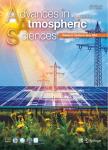A Modeling Study of Effective Radiative Forcing and Climate Response Due to Tropospheric Ozone
A Modeling Study of Effective Radiative Forcing and Climate Response Due to Tropospheric Ozone作者机构:Key Laboratory for Semi-Arid Climate Change of the Ministry of EducationCollege of Atmosphere ScienceLanzhou UniversityLanzhou 730000 Laboratory for Climate Studies of China Meteorological AdministrationNational Climate CenterChina Meteorological AdministrationBeijing 100081 Chinese Academy of Meteorological SciencesBeijing 100081 Department of Atmospheric SciencesUniversity of WashingtonSeattle98195USA
出 版 物:《Advances in Atmospheric Sciences》 (大气科学进展(英文版))
年 卷 期:2016年第33卷第7期
页 面:819-828页
核心收录:
学科分类:07[理学] 070602[理学-大气物理学与大气环境] 0706[理学-大气科学]
基 金:supported by the National Natural Science Foundation of China(Grant No.41575002)
主 题:tropospheric ozone effective radiative forcing climate effect BCC_AGCM2.0. I_CUACE/Aero
摘 要:This study simulates the effective radiative forcing (ERF) of tropospheric ozone from 1850 to 2013 and its effects on global climate using an aerosol-climate coupled model, BCC_AGCM2.0. I_CUACE/Aero, in combination with OMI (Ozone Monitoring Instrument) satellite ozone data. According to the OMI observations, the global annual mean tropospheric col- umn ozone (TCO) was 33.9 DU in 2013, and the largest TCO was distributed in the belts between 30°N and 45°N and at approximately 30°S; the annual mean TCO was higher in the Northern Hemisphere than that in the Southern Hemisphere; and in boreal summer and autumn, the global mean TCO was higher than in winter and spring. The simulated ERF due to the change in tropospheric ozone concentration from 1850 to 2013 was 0.46 W m-2, thereby causing an increase in the global annual mean surface temperature by 0.36°C, and precipitation by 0.02 mm d-1 (the increase of surface temperature had a significance level above 95%). The surface temperature was increased more obviously over the high latitudes in both hemispheres, with the maximum exceeding 1.4°C in Siberia. There were opposite changes in precipitation near the equator, with an increase of 0.5 mm d- 1 near the Hawaiian Islands and a decrease of about -0.6 mm d- 1 near the middle of the Indian Ocean.



